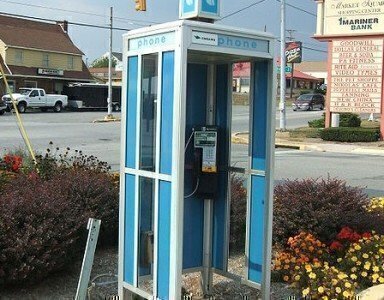On December 18, 1967, the Supreme Court ruled in Katz v. United States, expanding the Fourth Amendment protection against “unreasonable searches and seizures” to cover electronic wiretaps.
 Charles Katz lived in Los Angeles and was one of the leading basketball handicappers in the country in the 1960s. He made his money placing bets for interstate gamblers and keeping a share of the winnings. However, interstate gambling was illegal under federal law, so to avoid detection and prison, he used public telephone booths along Sunset Boulevard to conduct his business.
Charles Katz lived in Los Angeles and was one of the leading basketball handicappers in the country in the 1960s. He made his money placing bets for interstate gamblers and keeping a share of the winnings. However, interstate gambling was illegal under federal law, so to avoid detection and prison, he used public telephone booths along Sunset Boulevard to conduct his business.
Unfortunately for Katz, the Federal Bureau of Investigation caught on to his activities in February 1965 and moved quickly to collect evidence. The FBI identified the three phone booths Katz used on a regular basis and worked with the telephone company to take one out of service. The other booths were bugged and agents were stationed outside Katz’s nearby apartment. Based on the recorded conversations—“Give me Duquesne minus seven for a nickel!”—the FBI arrested Katz and charged him with an eight-count indictment.
The deck was stacked against Katz. After all, the evidence was damning—his coded language was easily identified as the chatter of a consummate gambler, so it would be difficult to avoid conviction. And his alternate claim that the FBI’s surveillance of the phone booths was unconstitutional ran up against decades of Supreme Court precedent, most notably Olmstead v. United States.
In that famous case, the ambitious bootlegger Ray Olmstead was brought down by a federal investigation that used a phone wiretapping system to track his calls for months. On June 4, 1928, a 5-4 majority led by Chief Justice William Howard Taft ruled that the wiretaps were permissible. Private telephone communications, the Court determined, were no different from casual conversations overheard in a public place. Plus, the wiretaps involved no physical intrusion or seizure of private property. Thus, the Fourth Amendment simply did not apply.
Nearly 40 years later, Katz found a more receptive audience at the nation’s high court. The Court’s 7-1 majority overturned the “trespass doctrine” established in Olmstead, with Justice Potter Stewart writing that the Fourth Amendment “protects people, not places” and is not dependent on intrusion into physical spaces. The Court also held that the Fourth Amendment applies to oral statements just as it does to tangible objects.
In arguing against Katz, the government had pointed to the fact that the phone booth was made partly of glass, thereby leaving Katz visible to the outside world. But the Court unequivocally rejected that argument as missing the point:
What [Katz] sought to exclude when he entered the booth was not the intruding eye—it was the uninvited ear. He did not shed his right to do so simply because he made his calls from a place where he might be seen. No less than an individual in a business office, in a friend's apartment, or in a taxicab, a person in a telephone booth may rely upon the protection of the Fourth Amendment. One who occupies it, shuts the door behind him, and pays the toll that permits him to place a call is surely entitled to assume that the words he utters into the mouthpiece will not be broadcast to the world. To read the Constitution more narrowly is to ignore the vital role that the public telephone has come to play in private communication.
In a separate concurrence, Justice John Marshall Harlan, Jr. fleshed out a test for identifying a “reasonable expectation of privacy”—one that is both subjectively understood by the individual and objectively recognized by society at large. In his concurrence, Justice Byron White argued for a “national security” exception to the Court’s decision, with Justices William Douglas and William Brennan responding forcefully in their joint concurrence.
And in his lone dissent, Justice Hugo Black, ever the faithful textualist, echoed Olmstead in arguing that the Fourth Amendment did not cover electronic surveillance under the plain text of the amendment. “No general right is created by the Amendment so as to give this Court the unlimited power to hold unconstitutional everything which affects privacy,” he wrote. “The history of governments proves that it is dangerous to freedom to repose such powers in courts.”
The long arm of Katz reaches into recent debates over mass data collection and GPS tracking. Indeed, in an age of increasing digital technology, the principle that the Fourth Amendment “protects people, not places” is more consequential than ever.
Nicandro Iannacci is a consultant for and former web content strategist at the National Constitution Center.







